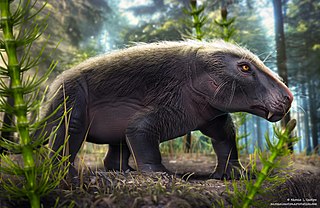
Carcharhinus is the type genus of the family Carcharhinidae, the requiem sharks. One of 12 genera in its family, it contains over half of the species therein. It contains 35 extant and eight extinct species to date, with likely more species yet to be described.
Anasibirites is an extinct genus of cephalopod belonging to the Ammonite subclass.
Argosirenites is an extinct genus of cephalopods belonging to the Ammonite subclass.

The South American land mammal ages (SALMA) establish a geologic timescale for prehistoric South American fauna beginning 64.5 Ma during the Paleocene and continuing through to the Late Pleistocene. These periods are referred to as ages, stages, or intervals and were established using geographic place names where fossil materials where obtained.

The Itaboraian age is a period within the Early Eocene geologic time epoch of the Paleogene, used more specifically with South American land mammal ages (SALMA). It follows the Riochican and precedes the Casamayoran age.
The Casamayoran age is a period of geologic time within the Early Eocene epoch of the Paleogene, used more specifically within the South American land mammal age (SALMA) classification. It follows the Itaboraian and precedes the Mustersan age.
The Deseadan age is a period of geologic time within the Oligocene epoch of the Paleogene to the Early Miocene epoch of the Neogene, used more specifically within the SALMA classification of South America. It follows the Tinguirirican and precedes the Colhuehuapian age.
The Colhuehuapian age is a period of geologic time within the Early Miocene epoch of the Neogene, used more specifically within the SALMA classification in South America. It follows the Deseadan and precedes the Santacrucian age.
The Santacrucian age is a period of geologic time within the Early Miocene epoch of the Neogene, used more specifically with SALMA classification in South America. It follows the Colhuehuapian and precedes the Friasian age.
The Huayquerian age is a period of geologic time within the Late Miocene epoch of the Neogene, used more specifically within the SALMA classification. It follows the Mayoan and precedes the Montehermosan age.

Ptychoceratodus is an extinct genus of prehistoric sarcopterygians or lobe-finned fish originally named as a species of Ceratodus in 1837. It was a lungfish from the Mesozoic era (Triassic-Cretaceous), and the only members of the family Ptychoceratodontidae. One species, P. oldhami, was named in 2018 based on remains from the Carnian-aged Tiki Formation (India). The first named species, which is also the type species, is P. phillipsi, which was named in 1837 by Louis Agassiz as a species of Ceratodus and moved to a separate genus in 1926.
Pillararhynchus is an extinct genus of prehistoric sarcopterygians or lobe-finned fish.
Orlovichthys is an extinct genus of prehistoric sarcopterygians or lobe-finned fish. Fossil evidence was found in Russia, and is from the Late Devonian period.
Tranodis is an extinct genus of prehistoric sarcopterygians or lobe-finned fish. It was a lungfish from the Upper Mississippian of North America.

Chelonoidis is a genus of turtles in the tortoise family erected by Leopold Fitzinger in 1835. They are found in South America and the Galápagos Islands, and formerly had a wide distribution in the West Indies.

The Kupferschiefer or Kupfermergel, is an extensive and remarkable sedimentary unit in Central Europe. The relatively monotonous succession is typically 30 to 60 centimetres and maximum 2 metres (6.6 ft) thick, but extends over an area of 600,000 square kilometres (230,000 sq mi) across the Southern Permian Basin. The Kupferschiefer can be found in outcrop or in the subsurface straddling six countries, including parts of the southern North Sea. The lateral equivalent outcropping in England is called Marl Slate.

Siriusgnathus is a traversodontid cynodont from the Carnian channel sandstones and mudstones of the Candelária Formation, belonging to the Santa Maria Supersequence of the Paraná Basin in southeastern Brazil. It includes one species, Siriusgnathus niemeyerorum and was described in 2018. The species epithet refers to the Niemeyer locality in Agudo, Rio Grande do Sul. It was found together with various archosauromorphs, dinosauromorphs and other cynodonts, such as Brasilitherium riograndensis, Brasilodon quadrangularis, Irajatherium hernandezi and Prozostrodon brasiliensis.

Pisco Basin is a sedimentary basin extending over 300 kilometres (190 mi) in southwestern Peru. The basin has a 2 kilometres (6,600 ft) thick sedimentary fill, which is about half the thickness of more northern foreland basins in Peru.







